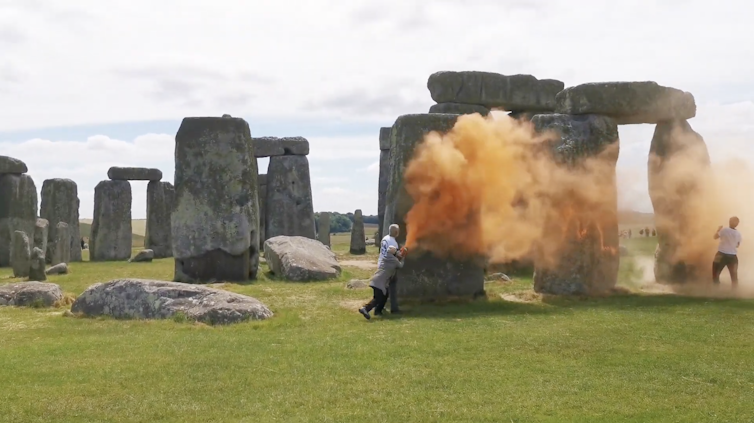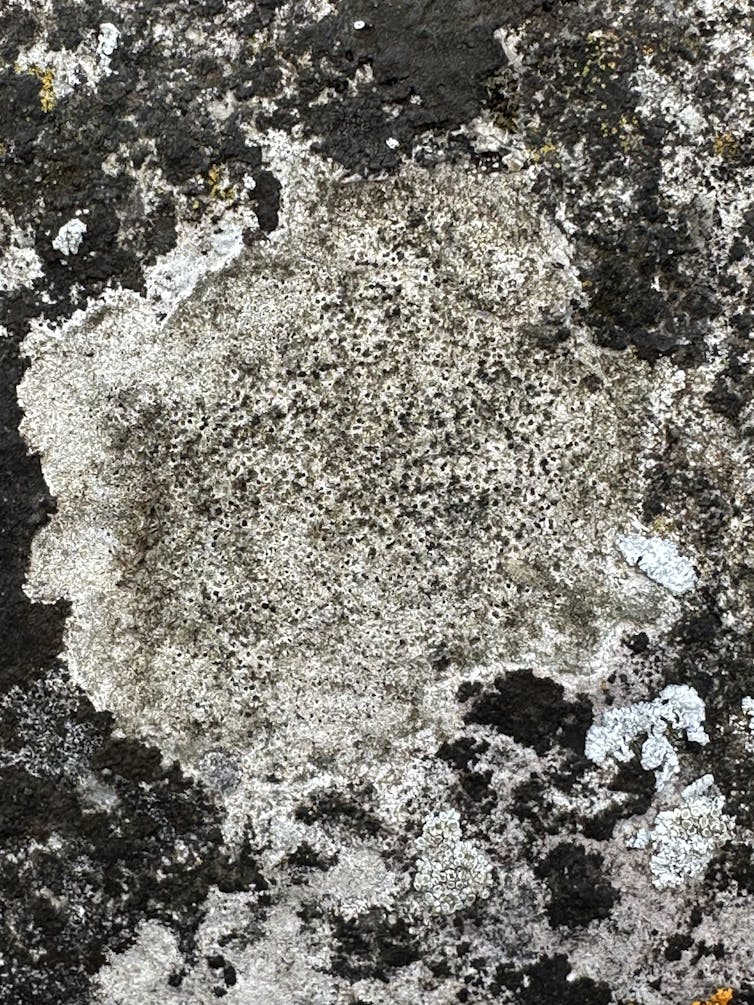
[ad_1]
Lakes on the stone, those “explosions that are still” are the great American poet Elizabeth Bishop, is not visible to most, which is great when you think about their prevalence. It seems that this importance is environmentally and culturally Something closer to vegetarian blindnessA well -known phenomenon and tendency to overlook the plants, which many of us define – when we face the strings for the first time – although this is not what they are at all.
Part of the problem is that they were not studied in schools because they are embarrassing strangers and are not seen to be commensurate with the goals of the scientific curricula. So I was surprised by the vision of the elderly jumping to the public imagination after a fair oil protest in Stonenig in the summer coup in June 2024.

Just stop the oil
It seems that a lot of anger was a reaction to Quote from one of the demonstrators About inactive stones: “It is time for us to think about what our civilization will take behind – what is our legacy? It is an inert for generations that works well with the stones – not the climate policy.” idle? “Well, what about the rare elders you grow on?” The response was from some people, and their opinion was separate from the stone, and others are more important.
The English heritage, the current guards in Stoneheng, Speak about stones As “a testimony to people’s desire – from prehistoric times to this day – to communicate with nature, land, sun and moon, as well as decisively, each other.” This publication has printed a response indicating that we must be more concerned with the effects of climate change on our cultural heritage rather than procedures that are not important to fair oil protesters.
What is more, Druid big He said that he was sympathetic to the group’s message, but he was criticizing their actions in the holy site, as he warned of additional measures to protect stones, given that the summer coup is the only day in the year that people can “communicate with stones and have a suitable relationship.”
The relationship-a word is often intended for relationships between people, people, animals, or other animals, and not people and what can be something else-at least in western eyes-as non-vibrant, non-lively or unlimited stones. Or are they?
For a tree specialist who specializes in waterwalk (or stone), the interesting thing for me is what the elders should say about stone and conclusion, their lack of life, and the comprehensive “vital” naming that Western thinking helps her.
This is because the elders transform our understanding of the stone in both environmental and cultural contexts, and this can have significant effects not only to preserve our cultural heritage, but also the broader field of memorization and how we understand and the natural world’s connection.

The Ideas Department is committed to a long -quality long press. Our editors work with academics from many different backgrounds who deal with a wide range of societal and scientific challenges.
What is exactly the lichen?
First of all, how we see the same insults change. Attempting to agree on a definition of kettles that leads them to one of the small Cubby holes in science has proven difficult to try to distinguish between the stone from the rocks. A Takaful Association Among the fungi (fungi) and the optical acting partner, algae or Cyanobacterium (Photobiont) is usually where we have reached. And our assimilation Linnaean classification system One of the living organisms that we deal with as we do one type, and we call them after fungi.
But the truth is, while all of these other living organisms are assigned the name of one type to sit at the end of one branch of Darwin’s life tree, the elders decrease several branches, and perhaps many branches, which gives us the side eye. They simply do not fit. This prompted some researchers to think about alternative ways to see them, including Recently defining them as complex ecosystems Because of the presence of microorganisms, including fungi and bacteria. This change in the sea The stabbedHowever, and debate It seems about “trees” that it will continue as it happened since the mid -eighties.
More than their biology
The idea that the elders are environmental systems, or may become environmental systems, really appeal to geographical sensitivities. It frees the trees from thinking over the species, but it does not overwhelm coexistence that also defines some of the relevant relationships. What we see and define as a lichen, can actually become more complicated over time.
One of the arguments against the idea that it is ecosystems is that it will require us to include the metal layer, soil or plant in which the elders grow. As the scientist William Sanders He writes, “For most biologists, the lodged that has been removed from his infrastructure is still.”
I spend a lot of time looking at the elders that pour the stone through the lens and under the microscope, and for me, the common interaction between the stone, the specifications of the elderly (or the thread similar to the thread) and the highus (or the main body) is intimate and dynamic, and in the end a relationship determines the same limits.
Lakes become more than their biology, mainly because they are at the site for such a wide time period, and even the substrate is often combined into its main body. Depending on the environment, individuals can colonize rocks and stone for decades, centuries, thousands of years until; I suggest that Some of the oldest in North Alaska are in the range of 10-11500 years. Thus, they put the boundary between vital (living) and vitality (non -living), which occurs in a connected when it escapes from a scale of species.
Verrucaria Baldensis It is the inner lichen that merges in the stone. On the roof of the stone, it can leave the pits where its fruitful bodies are separated. I call it the moon Lichen because this is exactly what appears to be close; The surface of the moon, the drilling becomes pits. But when you look at it from the top, or even in the cross section to see how you swell in the stone, you will be forgiven because you consider that it has disappeared, or you are actually a stone mainly. The relationship between biology and geology becomes so close that there is a good reason to look at both when monitoring it.

Nicholas Carterand CC by
The stone is extracted at the moment that is extracted or detected in another way, and its surface colonizes, through blue bacteria, algae, etc. This means that when this stone finds its way to the wall, building, memorial, or sculpture somewhere, it has already begun to shift, turning into something that works alive. Thus, on the roof, the carbon dioxide is taken from the atmosphere and replaces it with oxygen, and contributes to our Zero Aspirations.
And when the lichen is for this, at the right time, this stone becomes part of the elderly, and contributes to the biological diversity of the site. We do not see it, or think about it, but it happens. We just need to start seeing the stone differently, dynamically, more than minerals. As for the UNESCO World Heritage site such as Plenheim Palace, where I was holding a lichen poll, which is partially vision to enhance the environmental value of the site, seeing the stone in this way is very useful.

Michael Hoffman/Shutterstock
It can be said that a lot of how to determine something depends on our relationship with it and how we choose to see it. How do we appreciate living with regard to non -living plays on how to determine the elders; We need to recognize the importance and value of both. In doing this, we change our perception of the stone and our relationship with it. In order for there to be effective conservation, we need to evaluate stone and other non -living entities due to the close relationships concerned.
Reverse mode also occurs. In the field of heritage preservation, the stone, the biological, which is transmitted by humans, is often evaluated, as well as the biological increase, for example the elders, which can be found to colonize and occupy it. We tend to want to keep the stone rather than preserving it when it comes to the effects and cultural structures, so huge amounts of money are spent on cleaning historical buildings and sculptures, including the use of biomedic pesticides, and many of them It can be dangerous to human health and the environment.
Li down for resistance and flexibility
When we start to understand cultural contributions as well as the ecological benefits and preservation of the inspirations of the heritage that we start to turn to and reach more effective solutions that depend on nature with regard to the deterioration of stone works.
After all, the elders occur in Our folklore, we have stories for her soulThus, the flavor of the unfinished cultural heritage brought, as well as sometimes protecting stone surfaces from other deterioration factors. What interests here is that heritage scientists have often talked about stone in humanity, when diagnosed with dissolution, for example. Even Blue shapes and He has even memoryStoring previous shocks related to environmental pollution.
Al -Ashnat also affects the cultural and artistic reassessment of the stone, such as contemporary Artists and Book They explore the symbiotic relationships that the elders have to the stone, as they are seen as metaphors for resistance, flexibility and intercourse. In this way, the elders highlight the narration of Stone of the neighborhood, and the biology and geology in relation to the human condition.
There is an interesting parallel to drawing here in terms of life specified by relationships. A developing topic in anthropology focuses on chants between humans and the mineral world. In her article on thisEthnography in Braida Nadia discovers a European form of Spirituality “Self -proportions, intention, ability, and agency for non -human beings, and revealed a network between types of hidden relationships by Western natural view.”
At Piave, an Italian river where ancient vectors described by old gatherings as living organisms, and Breda refers to the anthropology of life where “stones live in this moving world of humans, stones and water” in a world in which they do not interact, “but they do not interact.”
Baca Juga: Great Secrets of Physics 5: Will we have a basic theory of life and awareness?
By monitoring the elders and listening to voices outside the Western perspective, we see sixty than life without life, a way to reconnect to the natural world – which we need strongly.
We form relationships and emotional attachments with the biological world in a relatively easily, but we need to take care of these ties with material elements as well, and not only when they carry cultural or symbolic importance. As such, we need to defend soil integration, for example, as much as to provide endangered species. Ethical discussions such as rights and preservation should not only focus on biology, and what we see in physical physicalism should be talking about in terms of moral obligations.
Stone is important for kettles as well as many human cultures, which represent more than the inactive substance, bearing the meaning, history and spiritual importance. Focusing strictly on bilateral discrimination blocks the integrated nature of ecosystems and reduces these broader environmental and human ties, which can provide valuable visions of sustainability and environmental supervision. This is less than discrimination, but to build more connections.
This article was in the book Award for the book, and it ran in partnership with Faber and Cortis Brown.
